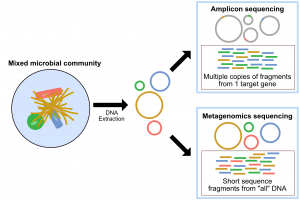
Metagenomics is the study of genetic material obtained directly from environmental samples, such as soil, water, and air, rather than from a single, isolated organism. This approach provides a comprehensive overview of the microbial diversity present in a sample and allows researchers to explore the functions and interactions of microbial communities.
Metagenomics sequencing is a type of DNA sequencing that enables the simultaneous analysis of the genetic material of all microorganisms (including bacteria, viruses, fungi, and other eukaryotes) present in a given sample, rather than just one species at a time. This approach is used to study the diversity, abundance, and interactions of microorganisms in various environments, including human gut, soil, ocean, and more. It provides a holistic view of the microbial communities and their contribution to the ecosystem and has numerous applications in various fields, including environmental studies, medical research, and biotechnology.
Allied Market Research has published a study report with the title Metagenomics Sequencing Market Size was Valued at USD 974.30 million in 2020, and is Projected to Garner USD 3.64 billion by 2028, registering a CAGR of 17.5% from 2021 to 2028.
What is the purpose of metagenomics?
The purpose of metagenomics is to study the collective genomic content and diversity of microorganisms in a specific environment or sample, including bacteria, viruses, fungi, and other microorganisms, without the need to isolate and culture each organism individually. This helps to understand the function and interactions of microorganisms in different environments and has applications in various fields such as medicine, agriculture, and environmental science.
How is metagenomic sequencing done?
Metagenomic sequencing is done by extracting the DNA or RNA from a sample of environmental or clinical material, such as soil, water, feces, blood, or tissue, and then using high-throughput sequencing technologies, such as Illumina or Oxford Nanopore, to generate millions of DNA or RNA reads. The reads are then assembled into contigs, or longer sequences, and annotated with reference databases to identify the species and functional elements present in the sample. The resulting metagenomic data can be used to study the diversity, abundance, and function of the microbes in the sample, as well as to infer their role in the ecosystem, the health of the host, or the pathogenesis of the disease.
Top Companies Of Metagenomic Sequencing
- Eurofins Genomics
- Illumina, Inc.
- Oxford Nanopore Technologies Ltd
- Pacific Biosciences of California, Inc.
- Thermo Fisher Scientific Inc.
- BGI Genomics Co., Ltd.
- PerkinElmer Inc.
- QIAGEN N.V.
- Macrogen Inc.
- Swift Biosciences Inc.
Get Sample PDF Report with Graphs and Figures Here
Challenges of Metagenomic Sequencing
What are the Factors that Drive the Metagenomic Sequencing Market?
The factors that drive the metagenomic sequencing market include:
- Increase in research and development activities for the discovery of new therapeutic targets and drug development.
- The rise of chronic diseases and the need for their diagnosis and treatment.
- The advancement of genomic technologies, such as high-throughput sequencing and the integration of metagenomics into the medical field.
- Increase in investment in life sciences and biotechnology industries.
- The growing demand for personalized medicine and the need to understand the role of microbes in human health and disease.
- The increasing demand for metagenomic sequencing in environmental biotechnology, agricultural biotechnology, and food safety.
- The rise of big data and the need to manage and analyze large amounts of metagenomic data.
- The growth of the healthcare industry and the increasing demand for cost-effective diagnostic solutions.
- The growing awareness about the importance of understanding the human microbiome and its impact on health.
- The increasing number of collaborations and partnerships between academic institutions, biotech companies, and pharmaceutical companies to advance metagenomic research and applications.

